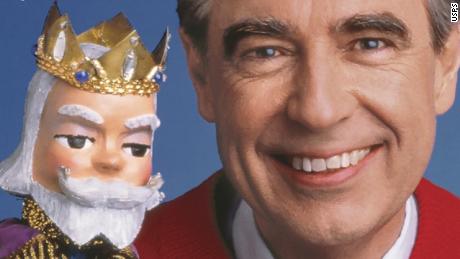His was a singular presence in the medium, marked by a kindness and understanding that endeared him to children and parents alike for 31 seasons of "Mister Rogers' Neighborhood." Now, Tom Hanks has assumed the host's signature red sweater in "A Beautiful Day in the Neighborhood," the new film based loosely on a 1998 profile of Rogers for an "American Heroes" issue of Esquire. Journalist Tom Junod dug into Rogers' TV persona and discovered it wasn't make-believe at all: By his account, the man was just as caring in practice as he appeared onscreen.Here's what readers learned about the beloved Mister Rogers when the article ran, four years before his death.
He had a fan in Koko the gorilla
Mister Rogers began every show by changing out of his loafers, catching them in his hands and slipping on sneakers. That's what happened when he met Koko, the friendly gorilla and sign language star. He told Junod that Koko, an avid "Mister Rogers" viewer, took off his shoes when they met, just like he did onscreen — right after she pulled him in for a close hug.
He was a vegetarian who napped every day and never watched TV
Junod outlines Rogers' stringent schedule: He'd wake up every morning at 5:30 a.m. to read and pray for those who'd asked him to. Then he'd take a daily dip in the pool for exercise. An episode taping would follow. He'd take a late afternoon nap after returning home from work every day and end each day at 9:30 p.m., sleeping for eight uninterrupted hours. He didn't eat meat (he told the Los Angeles Times in 1997 he didn't eat "anything with a mother") or even watch TV, Junod wrote. But he did weigh himself daily and famously claimed he weighed the same amount every time–143 pounds.It's a number with special meaning that he snuck into his show several times. With one letter in "I" (1), four letters in "love" (4) and three letters in "you" (3), Mister Rogers took the number to represent one of his favorite phrases– "I love you."
He discovered television for the first time after coming home from college
Rogers hardly knew about television before he decided to devote his life to it. On a break from school, he returned to his family home in Latrobe, Pennsylvania, to find a television set. He didn't like how producers were using TV — "There were people throwing pies at each other," he told Junod with disdain — so he set out to change the landscape.Before he became Mister Rogers, he was the puppeteer on "The Children's Corner," where many of his most famous puppets, like Daniel Striped Tiger and Lady Elaine, were introduced to viewers.
He was colorblind
 The walls behind the "Mister Rogers' Neighborhood" set were painted sky-blue, but the man in front of them never knew it. Rogers was born colorblind, Junod wrote, so he never witnessed the technicolor beauty of his Neighborhood of Make-Believe.But he could dream of what the walls looked like. "I imagine they're blue," he told Junod.
The walls behind the "Mister Rogers' Neighborhood" set were painted sky-blue, but the man in front of them never knew it. Rogers was born colorblind, Junod wrote, so he never witnessed the technicolor beauty of his Neighborhood of Make-Believe.But he could dream of what the walls looked like. "I imagine they're blue," he told Junod.
He relieved himself in a cemetery
Mister Rogers was a devout Christian who prayed every day of his life, so he surprised Junod when he urinated in a cemetery where his family members were buried.He took the reporter to his family's mausoleum and passionately shared stories about them until suddenly, without a "hint of shame or embarrassment," he left to find a corner of the graveyard to relieve himself, Junod wrote.







